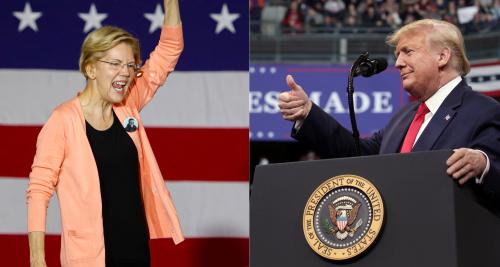Could President Donald Trump be the savior of Europe? It’s an unusual thought, particularly given some of the trade-war rhetoric being hurled across the Atlantic. But fiscal stimulus in the United States provides an opportunity for Europe to do some spending of its own—and to get a bigger growth impact than it normally would. With unemployment still at 21 percent in Greece, 17 percent in Spain, and around 11 percent in Italy and Portugal, some increased spending might not be such a bad idea.
Trump’s fiscal stimulus is no small thing. The U.S. Tax Cuts and Jobs Act, and the decision of Congress to raise spending limits over the next two years, implies a significant easing of U.S. fiscal policy of around 1 percent of GDP in both 2018 and 2019, according to the OECD. A forthcoming Brookings working paper uses general equilibrium modeling to explore the cross-border implications of stimulus between G-20 countries, including the opportunities that stimulus in one country creates for others.
The implications of U.S. stimulus for the U.S. economy, in the short-run at least, are positive. Relative to the baseline, GDP would likely increase by around 0.63 percent in the first year, slightly less than the OECD’s estimate of 0.67 per cent. This comes from the sugar-hit to aggregate demand as fiscal policy expands, as well as a boost to investment and consumption of around 0.1 and 0.15 percent, respectively, from temporarily higher growth and incomes.
But this short-term boost in GDP is partially offset by two related things. The first is higher interest rates, which act to constrain the increase in investment and consumption. The Fed is already forecasting three interest rate rises this year. But with fiscal stimulus occurring when the U.S. economy is at (or at least somewhere near) full employment, and with a Fed that seems eager to rebuild monetary policy space, more rate rises could well be in the cards.
The second offsetting effect is an appreciated exchange rate. Higher interest rates, increased demand for imports, and the need to finance increased U.S. government debt will likely see capital flow into the U.S., pushing up the real exchange rate in the first year. This would reduce net exports by around 0.6 percent, partially offsetting the short-term benefit of fiscal stimulus.
For America’s trading partners, however, the opposite is true. A stronger U.S. dollar means their currencies are relatively weaker, boosting their net exports. This is where the opportunity for Europe comes in.
One of the key lessons that came out of the global financial crisis was that countries get a bigger bang-for-their-buck when they undertake fiscal stimulus together than when they do it alone. The logic is straightforward. As above, when a country undertakes stimulus alone, an appreciated exchange rate tends to offset some of the short-term benefits of stimulus. But when your trading partners are stimulating at the same time, much of this exchange rate effect is neutralized. Combined with increased demand for your exports, this means a bigger bang for your stimulus buck.
How much bigger? For the euro area, it is about a 31 percent (a weighted-average across euro area economies). That is, the benefit to the euro area economy from every $1 spent on fiscal stimulus will be about 31 percent larger if it undertakes stimulus at the same time as the U.S. Not all euro area economies benefit to the same extent, given different industrial profiles and links to the U.S. economy. The benefit to France from simultaneous U.S.-euro area stimulus is about 11 percent. For Italy, it is 18 percent. For Germany, which has the most fiscal space, it is 60 percent. For the rest of the euro area collectively, where unemployment is the highest, it is an average of 50 percent.
Coordinated stimulus results in a bigger impact on employment and wages, too—both of which are critical challenges in the euro area periphery. For these economies, the increase in labor demand is 26 percent higher and the increase in wages is 47 percent higher when fiscal stimulus in the euro area is coordinated with the U.S.
This is not small change. A return on investment that is 11 to 60 percent higher than normal would alter the decisions of most investors. It should alter the decisions of euro area policymakers, too.
While the financial crisis is often referred to in the past tense, unemployment in the euro area periphery remains at eye-wateringly high levels, particularly among young people. Youth unemployment in Greece is at 47 percent. It is 39 percent in Spain and 38 percent in Italy. While unemployment rates are declining from their peaks, progress is painstakingly slow. If unemployment continues to decline at its current rate, it will not be until 2028 that Italy and Portugal reach the current average unemployment rate for the OECD. For Spain, it will be 2038. For Greece, it will be 2042. This means that a Greek person who is 21 years old today will be 45 by the time she sees a normal rate of unemployment in her country. Make no mistake, the human cost that sits behind these numbers is catastrophic.
Yet, Greece is currently running budget surpluses. It ran a structural budget surplus in 2016 of 3.2 percent of GDP as part of its third economic program with the International Monetary Fund and European Union authorities. Germany is also in surplus that, like the Netherlands, continues to improve. Germany’s external position has improved even further, with a current account surplus—the difference between its relatively high level of savings and low level of investment—of now 8.3 percent of GDP: more than 10-times the OECD average.
In short, if there was ever a good time for increased spending in the euro area, now would be it. Increased investment in infrastructure is the obvious choice. It boosts growth and employment in the near-term through fiscal stimulus (the benefits from which are almost a third larger in the current economic environment) and gives higher productivity and wages in the long-term. A reasonable estimate is that, for every 10 percent increase in the stock of infrastructure capital, productivity in private sector output rises by 0.8 percent. For Germany, this would translate into GDP being roughly 2.5 percent permanently larger in the longer-term.
Increased government investment will be critical to supporting near-term growth while the euro area continues its longer-term integration agenda, and the Trump administration has presented a perfect opportunity to do it. Infrastructure investment makes economic sense, is permitted under the rules of the EU’s Growth and Stability Pact, and is consistent with the EU’s Investment Plan. All that is required is the political will to act.







Commentary
Could President Trump be the savior of Europe?
April 12, 2018